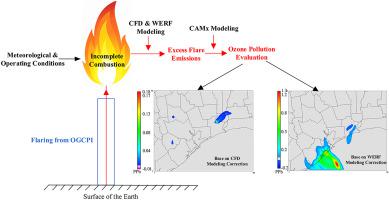当前位置:
X-MOL 学术
›
Atmos. Environ.
›
论文详情
Our official English website, www.x-mol.net, welcomes your feedback! (Note: you will need to create a separate account there.)
Effect of industrial flare DREs derived by CFD and WERF on ozone pollution through CAMx simulation
Atmospheric Environment ( IF 5 ) Pub Date : 2020-10-01 , DOI: 10.1016/j.atmosenv.2020.117723 Sijie Ge , Sujing Wang , Qiang Xu , Thomas Ho
Atmospheric Environment ( IF 5 ) Pub Date : 2020-10-01 , DOI: 10.1016/j.atmosenv.2020.117723 Sijie Ge , Sujing Wang , Qiang Xu , Thomas Ho

|
Abstract Flare is the last safety measure for daily operations in oil, gas & chemical process industries (OGCPI). However, an excessive flaring releases large quantity of emissions of VOCs and NOx, which may suddenly enhance local ozone as a secondary pollution. Normally, the flare destruction and removal efficiency (DRE) of 98% or 99% is regulated as the national standard and presumed for industrial practices in the U.S. Unfortunately, real DRE values could be much lower than the standard due to impact factors including various meteorological and operating conditions such as the cross-wind speed, flare jet velocity and heating value of combustion. Thus, it is critically important to explore the sensitivity of the regional ozone impact due to low DREs of OGCPI flare combustions. In this paper, a systematic methodology has been developed to examine ozone impacts due to the low flare DREs, which have never been systematically studied before. The DRE formulas were derived from computational fluid dynamic (CFD) modeling and Water Environment Research Foundation (WERF) results and then employed to recompile the point source emission inventory. After that, comprehensive air quality model with extensions (CAMx) was employede to simulate and quantify local ozone changes impacted by flare emissions of OGCPI. Case studies indicate that the maximum hourly ozone increments due to the low DRE through CFD and WERF modeling is 0.18 ppb and 1.3 ppb, respectively. This study could enrich fundamental understandings of industrial point source emissions and provide the quantitative and valuable support for the ozone pollution caused by OGCPI flare emissions under low DRE instead of standard values.
中文翻译:

通过 CAMx 模拟 CFD 和 WERF 得出的工业耀斑 DRE 对臭氧污染的影响
摘要 火炬是石油、天然气和化学加工工业 (OGCPI) 日常操作的最后一项安全措施。然而,过度的燃烧会释放大量的VOCs和NOx,这可能会突然增强作为二次污染的局部臭氧。通常情况下,98% 或 99% 的火炬销毁和去除效率 (DRE) 被规定为国家标准,并假定为美国的工业实践。不幸的是,由于各种气象因素等影响因素,实际的 DRE 值可能远低于标准。以及运行条件,如侧风速、火炬射流速度和燃烧热值。因此,探索由于 OGCPI 火炬燃烧的低 DRE 引起的区域臭氧影响的敏感性至关重要。在本文中,已经开发了一种系统的方法来检查由于低耀斑 DRE 造成的臭氧影响,这在以前从未被系统地研究过。DRE 公式源自计算流体动力学 (CFD) 建模和水环境研究基金会 (WERF) 结果,然后用于重新编制点源排放清单。之后,采用带扩展的综合空气质量模型(CAMx)来模拟和量化受 OGCPI 耀斑排放影响的局部臭氧变化。案例研究表明,由于通过 CFD 和 WERF 建模的低 DRE,每小时的最大臭氧增量分别为 0.18 ppb 和 1.3 ppb。
更新日期:2020-10-01
中文翻译:

通过 CAMx 模拟 CFD 和 WERF 得出的工业耀斑 DRE 对臭氧污染的影响
摘要 火炬是石油、天然气和化学加工工业 (OGCPI) 日常操作的最后一项安全措施。然而,过度的燃烧会释放大量的VOCs和NOx,这可能会突然增强作为二次污染的局部臭氧。通常情况下,98% 或 99% 的火炬销毁和去除效率 (DRE) 被规定为国家标准,并假定为美国的工业实践。不幸的是,由于各种气象因素等影响因素,实际的 DRE 值可能远低于标准。以及运行条件,如侧风速、火炬射流速度和燃烧热值。因此,探索由于 OGCPI 火炬燃烧的低 DRE 引起的区域臭氧影响的敏感性至关重要。在本文中,已经开发了一种系统的方法来检查由于低耀斑 DRE 造成的臭氧影响,这在以前从未被系统地研究过。DRE 公式源自计算流体动力学 (CFD) 建模和水环境研究基金会 (WERF) 结果,然后用于重新编制点源排放清单。之后,采用带扩展的综合空气质量模型(CAMx)来模拟和量化受 OGCPI 耀斑排放影响的局部臭氧变化。案例研究表明,由于通过 CFD 和 WERF 建模的低 DRE,每小时的最大臭氧增量分别为 0.18 ppb 和 1.3 ppb。



























 京公网安备 11010802027423号
京公网安备 11010802027423号